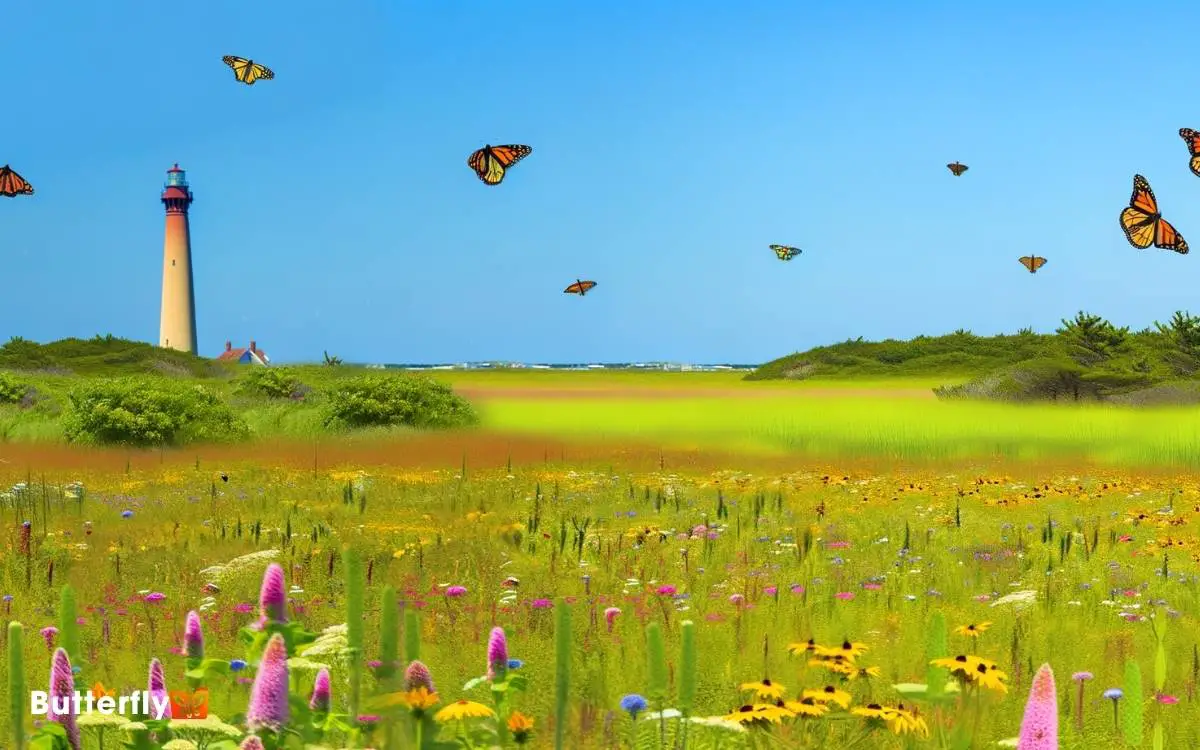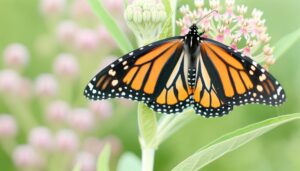Monarch Butterflies in Cape May Nj: Find Out Here!
Experience the awe-inspiring migration of monarch butterflies in Cape May, NJ. Cape May serves as an essential rest stop, providing monarchs with vital resources like milkweed and goldenrod.
These butterflies, traveling thousands of miles, utilize thermal air currents to conserve energy. Conservation stations in Cape May meticulously monitor their journey, and local organizations actively participate in habitat preservation by planting milkweed.
The unique geography of Cape May protects monarchs from harsh winds and predators, offering a sanctuary for rest.
You’ll discover more about these incredible creatures and ongoing conservation efforts by exploring further.

Key Takeaways
Monarch Butterfly Lifecycle
The monarch butterfly lifecycle consists of four distinct stages: egg, larva (caterpillar), pupa (chrysalis), and adult.
First, a female lays tiny, oval eggs on milkweed leaves. You’ll notice they hatch into larvae after about four days. These caterpillars voraciously consume milkweed, growing through five instars, or molting phases.
After roughly two weeks, the caterpillar finds a secure spot to form its chrysalis. This pupa stage lasts about ten days, during which metamorphosis occurs.
Finally, the adult butterfly emerges, with wings that need to dry and harden before it can fly.
Understanding each stage is essential for conservation efforts, as it helps you know what conditions and resources the monarchs need to thrive and survive.
The Great Migration
You’ll find the great migration of monarch butterflies a marvel of endurance and precision, spanning thousands of miles across continents.
These butterflies navigate formidable natural obstacles, including mountains, deserts, and oceans. Cape May serves as a critical rest stop, providing essential resources for their journey.
Journey Across Continents
Setting off on an epic journey, monarch butterflies traverse thousands of miles from their breeding grounds in North America to their winter sanctuaries in central Mexico.
You’ll find that each generation undertakes a portion of this migration, often covering up to 100 miles per day. Utilizing thermal air currents, they conserve energy during flight.
Their navigational prowess is remarkable, relying on a combination of the sun’s position and an internal circadian clock to maintain their southern trajectory.
The journey involves crossing diverse terrains and climates, requiring precise timing and adaptability.
Navigating Natural Obstacles
Traversing natural obstacles demands that monarch butterflies skillfully dodge predators, maneuver through adverse weather conditions, and find suitable roosting sites along their migration route.
You’ll notice that they exhibit remarkable adaptive behaviors. Monarchs use their keen sense of direction and innate ability to detect geomagnetic cues for navigation. To evade predators such as birds and spiders, they employ erratic flight patterns.
Weather poses significant challenges; strong winds can displace them off course, while heavy rain can hinder their flight capability. As a result, they use thermal currents to conserve energy and gain altitude.
Suitable roosting sites, often trees or shrubs, offer protection from the elements and a place to rest. This intricate dance secures their survival during the arduous journey.
Rest Stops in Cape May
Among the various critical rest stops for monarch butterflies during their great migration, Cape May in New Jersey stands out as an essential sanctuary where they can replenish energy and seek refuge from the elements.
You’ll find that Cape May offers a strategic location, rich in nectar sources such as milkweed and goldenrod. These plants provide essential sustenance for the butterflies’ long journey to Mexico.
Additionally, the region’s unique geography, featuring coastal marshes and protected woodlands, offers shelter from harsh winds and predators.
Monitoring stations in Cape May also provide crucial data on migration patterns, helping scientists understand and protect these delicate travelers.
Cape May’s Role
You’ll find Cape May to be a crucial waypoint in the monarch butterfly’s migration patterns due to its unique geographical position.
The region’s conservation efforts focus on preserving essential habitats and implementing initiatives to support their journey.
Understanding these factors highlights Cape May’s indispensable role in sustaining the monarch population.
Butterfly Migration Patterns
Cape May, NJ plays an essential role in the migration patterns of monarch butterflies, serving as a key stopover point where these insects rest and refuel before continuing their journey to Mexico.
Monarchs travel thousands of miles, guided by environmental cues such as daylight length and temperature changes.
Cape May’s unique geographical position at the southern tip of New Jersey funnels the butterflies into a concentrated area, making it an ideal location for rest and resource accumulation.
During this stop, monarchs replenish their energy by feeding on nectar from native flowers. This refueling is important for completing their transcontinental migration. Cape May provides the necessary habitat and resources to support this critical phase of their journey.
Conservation Efforts Initiatives
Local organizations in Cape May have implemented targeted conservation initiatives to guarantee the monarch butterflies’ survival during their migration.
You’ll find that groups like the Monarch Monitoring Project meticulously track butterfly populations, providing essential data for conservation strategies.
They plant milkweed and other nectar-rich flora to create crucial habitats, ensuring monarchs have the resources they need.
Additionally, educational programs inform the public on how to support these efforts, making community involvement a cornerstone of the initiative.
By reducing pesticide use and preserving natural landscapes, Cape May’s conservationists are actively enhancing the monarchs’ migratory success.
Your understanding of these technical, precise actions can empower you to contribute to these critical conservation efforts.
Optimal Viewing Times
To witness the peak migration of Monarch butterflies in Cape May, NJ, plan your visit during late September to mid-October when the population density is at its highest.
This period is ideal due to several factors:
- Temperature: Monarchs prefer temperatures between 55°F and 75°F, which is typical in Cape May during these months.
- Wind Conditions: Favorable northwesterly winds aid the butterflies’ southward journey, concentrating them in the Cape May area.
- Day Length: Shorter days trigger the migratory behavior, making this time frame perfect for observation.
Environmental Challenges
While you marvel at the spectacle of Monarch migration, it’s important to understand the environmental challenges these butterflies face, including habitat loss, climate change, and pesticide exposure.
Deforestation and urbanization reduce the availability of milkweed, their primary food source and breeding ground.
Climate change disrupts migration patterns and breeding cycles, leading to mismatched timing with milkweed availability. Additionally, temperature fluctuations can cause physiological stress.
Pesticide exposure, particularly from neonicotinoids, negatively impacts their nervous system, leading to decreased survival rates. Agricultural practices that eliminate milkweed and other native plants further exacerbate these issues.
Understanding these challenges is vital for appreciating the vulnerabilities Monarchs face and recognizing the need for informed actions to support their survival.
Conservation Efforts
Conservation efforts for Monarch butterflies in Cape May, NJ, focus on habitat restoration, public education, and scientific research to mitigate the threats these insects face. By restoring native milkweed and nectar plants, you provide essential resources for breeding and migration.
Public education campaigns raise awareness about the importance of these plants and how to cultivate them. Scientific research monitors Monarch populations, migration patterns, and environmental impacts, ensuring data-driven strategies.
Here’s what you can do:
- Plant Native Species: Incorporate milkweed and nectar plants into your garden.
- Educate Yourself and Others: Participate in local workshops and spread awareness.
- Support Research: Contribute to or engage in scientific studies focusing on Monarch conservation.
These actions collectively bolster Monarch survival.
Community Involvement
Engaging the local community in Cape May, NJ, amplifies the impact of Monarch butterfly conservation efforts by fostering a collective sense of responsibility and action.
You can participate in organized tagging programs, where volunteers meticulously catch, tag, and release Monarchs to track their migratory patterns.
Join educational workshops that detail habitat restoration techniques, emphasizing the planting of milkweed and nectar-rich flowers essential for Monarch survival.
Collaboration with local schools and organizations helps in spreading awareness and involving younger generations in hands-on conservation activities.
Community-driven citizen science projects, such as data collection on Monarch sightings, provide valuable information to researchers.
Your involvement promotes sustained conservation efforts, creating a ripple effect that extends beyond Cape May, promoting a healthier ecosystem for Monarchs nationwide.
Visiting Cape May
Cape May offers numerous opportunities for observing Monarch butterflies in their natural habitat, especially during their peak migration periods in late September and early October.
When visiting, you’ll want to maximize your experience:
- Location: Head to Cape May Point State Park. This area is renowned for its dense Monarch populations and offers excellent vantage points.
- Timing: Plan your visit during early morning or late afternoon when butterflies are most active. The cooler temperatures make them more visible and easier to photograph.
- Guided Tours: Take advantage of local guided tours. These tours provide expert insights into butterfly behavior and the most favorable observation spots.
Conclusion
When you visit Cape May, you’re not just seeing butterflies; you’re witnessing a miracle of nature. The monarchs’ lifecycle, their epic migration, and the challenges they face all come to light here.
With community involvement and dedicated conservation efforts, you can help guarantee these butterflies don’t fade away. So, mark your calendar for peak viewing times after all, it’s the early bird that catches the worm.
Your visit makes a difference in preserving this breathtaking phenomenon.






